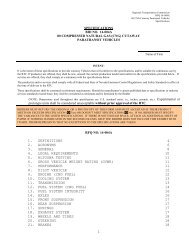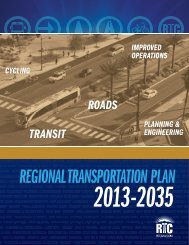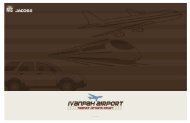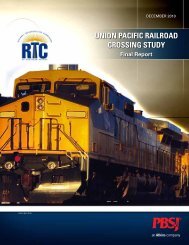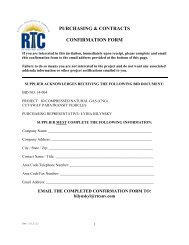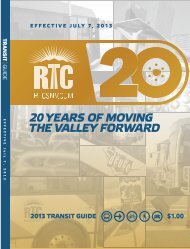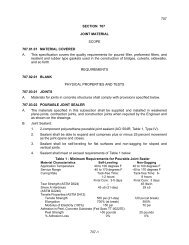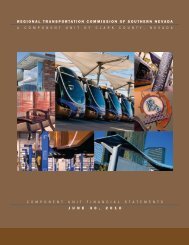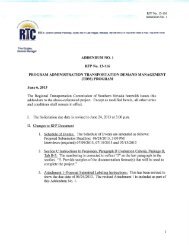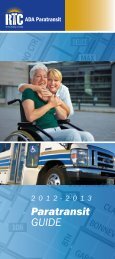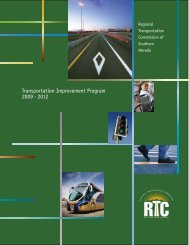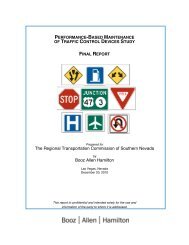(Blue Diamond Road) Corridor Study - Regional Transportation ...
(Blue Diamond Road) Corridor Study - Regional Transportation ...
(Blue Diamond Road) Corridor Study - Regional Transportation ...
Create successful ePaper yourself
Turn your PDF publications into a flip-book with our unique Google optimized e-Paper software.
6. SR-160 <strong>Corridor</strong> Improvement Plan RTC SR-160 <strong>Corridor</strong> <strong>Study</strong><br />
Preliminary NDOT intersection<br />
EXHIBIT 6-4: Right-Turn Island<br />
drawings (included in Appendix C)<br />
indicate that some right-turn lanes<br />
turn short of traffic islands, which<br />
would make it difficult to implement<br />
queue-jumping. An example of this is<br />
shown in EXHIBIT 6-4, which shows<br />
westbound SR-160 at Jones Blvd. RTC<br />
should work with NDOT to ensure that<br />
the highway design does not preclude<br />
transit-supportive features such as<br />
queue-jumping lanes.<br />
No right-turn lane is planned for eastbound SR-160 at Rainbow Blvd. A major Park & Ride<br />
facility is proposed on BLM land southeast of this intersection, which would require<br />
eastbound buses to turn south on Rainbow to access the facility. Lacking a right-turn lane<br />
onto Rainbow Blvd., eastbound buses could be unnecessarily delayed at this intersection. If<br />
a different access route to this Park & Ride is provided, or even if it is never built, the lack<br />
of a right-turn lane would preclude queue-jumping at Rainbow Blvd.<br />
6.4.2 Left Turn Lanes<br />
The median on the widened section of SR-160 will be 29 feet wide between intersections,<br />
which will narrow to five feet at each intersection, thus providing space for up to two 12 foot<br />
turn lanes. The space for these two lanes can be configured in three ways:<br />
1. Both lanes are left turn lanes for general traffic.<br />
2. There is only one left turn lane; the lane to the right is an unused buffer area.<br />
3. The left lane is the turn lane for general traffic, with the right lane being a turn lane<br />
for buses only.<br />
The main determinant of which option is used is generally based on the anticipated number<br />
of vehicles that will be turning, although the width of the receiving roadway is also a factor.<br />
The intersection at Arville Street, shown in EXHIBIT 6-5 at the end of this section, will be<br />
configured with the first two of these configurations. There will be two left turn lanes from<br />
eastbound SR-160 to northbound Arville Street, but one left turn lane and one buffer lane<br />
from westbound SR-160 onto southbound Arville Street.<br />
NDOT’s anticipated configuration is not yet available for all intersections, including Torrey<br />
Pines Boulevard, where westbound buses would be turning left from SR-160. If NDOT<br />
determines that two westbound general traffic left turn lanes are not required, consideration<br />
could be given to implementing a bus-only left turn lane in lieu of a buffer lane (Option 3<br />
above) at this location.<br />
6-6



